 Gondwana Telescopes Marana 12 Telescope Review
Gondwana Telescopes Marana 12 Telescope Review
I ponder this old chestnut of wisdom as I survey my slowly swelling mouth in the mirror. There are two distinct divots in my fattening, bloodied top lip – courtesy of my front teeth – and while shielded from view by an equally expanding bottom lip, the salty taste of blood tells me there is more damage out of sight. I valiantly wonder if the throbbing sensation is going to affect my averted vision later in the night.
What has the poor state of my face got to do with new Australian company Gondwana Telescopes and their line of travel telescopes?
Well, the thing is I gave myself a double fat lip by trying to wrestle my 16-inch rolled-steel truss Dobsonian out from the under the stairs. A growing family has pushed my scope space gradually into the confines under the stairs; optics are precious, especially big ones, and I just refuse to store my scope in the garage for fear of dust – and two crazed cats who are liable to do anything, particularly exceedingly expensive anythings.

This damage was done getting the rocker box out and, while I subsequently wrestled the LTA out successfully, bloodied lips and all, I couldn’t help but wonder what havoc I may one day wreak getting the truly heavy mirror-bearing bit of my astronomy gear out of the house.
Unless … I lighten things up!
I must confess – I have always been a fan of a good, solid scope. I can’t tell you why, exactly: after all, I almost slipped a disc as a 16-year-old when I used to wrestle a cardboard-tube Meade DS-16 onto an equatorial mount in the late 1980s. Fortunately, my poor father was always roped into the process (sorry about the hernia, dad!), but the views of M104 (albeit swimming in a circle of seagull stars) was always worth it.
Solid equals stable, right? Protected optics. Rock solid mounts. Views that sit where you put them, and images that don’t shiver in the eyepiece like a kid at his first late-night horror flick.
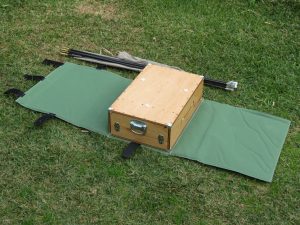
Well, maybe not.
In this era of everything electronic and otherwise that opens and shuts on a Dobsonian – plus enough mirror fans to lift them into higher orbit than the Hubble Telescope – sometimes the simple premise behind the design gets lost.
Balance it well so it works. Give your optics a chance to perform without the hindrance of their constraints. It really isn’t rocket science (although, granted, you are pointed at the heavens).
The term travel scope may well apply to pretty much any telescope that isn’t nestled comfortably in an observatory, or has wheels and stays set up in storage. By sheer virtue of increasing light pollution and our pursuit of suitably dark skies, it is a case of have scope, will travel.
Gondwana Telescopes founder and scope builder Alexander Massey dropped the 12-inch Marana into me for review one rainy

Sunday afternoon on his way back from the annual Ice in Space Astro Camp in a sleepy little rural spot called Lostock in NSW, Australia.
As fellow artists at the eyepiece, it was a good chance to have a yarn and compare some sketches – it’s the only way to really see what goes into an astro sketch, and we both agreed that it is a dying art that transcends photography in showing exactly what can be seen by amateur observers.
Being an artist of note, it was no surprise that Alex would deliver a scope that looks like a real piece of art. Seeing the Marana – an Aboriginal word meaning ‘stars’ – assembled really does get you wondering if it is form that follows function, or the other way around. Like everything else in this world, passion for a pursuit really does shine through when it comes to creating.
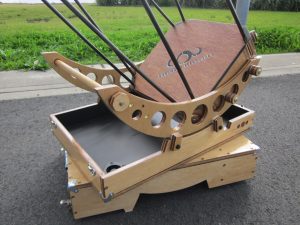
This scope arrives in two parts: a nicely crafted box (the one I reviewed was wrapped in the optional swag) and a tailor-made bag containing the poles (Images 1, 2 and 3).
The box contains no weight-reducing holes (Image 4); the design here is for a travel scope and, at least in Australia, getting to dark skies often involves dodgy bush roads full of potholes big enough to swallow a small car and ruts that may draw a morning-light search party. Bouncing cars often bring unwanted flying bits that can easily sail into such a box and mess with the optics. You want to be able to pack without fear of damaging your scope!
And I can’t say they were necessary, as the travel box was easily light enough to pick up by the handles and not only put it in and out of a car, but carry it up a winding staircase to take in a northerly view of Mars from my top deck at home. The Marana design also lends itself to be ‘carried’ by components, rather than just as one 21-kilogram (46.3-pound) piece, should weight be a consideration. The single heaviest component is the mirror box at 10.5 kilograms (23.1 pounds).
Unclipping the travel case reveals the well-packed contents that stay put regardless of travel motion (Image 3).
The removable secondary clips tightly into its small niche within the box; a small built-in compartment stores all the

necessary fasteners and hardware needed to get you in business.
Putting the Gondwana Telescopes Marana together isn’t hard at all. Alex gave me some verbal instruction and a single demonstration. My first attempt took about 20 minutes as I was taking my time. This fell to around the 15-minute mark after a few goes, and I reckon after six months of use you’d be putting it up under 10 minutes – not that it’s a race … but clouds and optimum viewing conditions can be awfully pushy customers at times.
Poles bolt in to the LTA, then bolt onto the UTA. Side bearings bolt onto the side of the LTA and the brace similarly bolts in, all with handmade bolts capped with nicely finished plywood knobs (Image 4). The pivot bolt drops into the mount, which
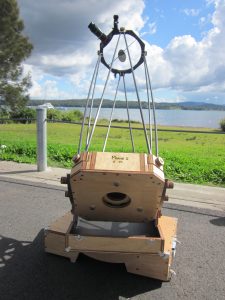
slots onto the base. Like I said, not complex. Drop the secondary into place – the magnet and guiding components clip it firmly in place – then slide the red-dot finder into position, strap the shrouds (one each for top and bottom into position) and you’re almost ready. Four Teflon-coated guides screw into position to keep the tube assembly from wandering out of position on the mount.
For collimation, there are thumb screws on the secondary which are always a snap to use (Image 5). The primary is collimated using a handmade device that clips over the collimating bolt heads (Image 6). It’s another handmade touch that makes good, simple sense. One subtle design aspect of the collimation system is it also reduces the overall volume of the mirror box, and makes for a more compact stowed scope. This Dob is quite clever like this in quite a few elements of design.
So, the Gondwana Telescopes Marana is together. The tube assembly is so light you can pick it up with little effort with one hand, using the other hand to balance and guide it into position.
Impressions?
What strikes you about this Dob – apart from the feel of a handcrafted instrument built by someone with an acute understanding of the craft – is twofold: the bearings are big; and it is quite unusual in that the struts bow out (see caption image).
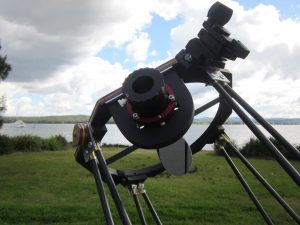
The bearings are a whopping 60 cm – that’s a whopping 24 inches. That’s as big as you get for a lot of premium 18-inch scopes these days, and this is a 12-inch scope.
As will be discussed, this means counterweights don’t get much of a say in the performance of this scope. It also means a lightweight scope, far from feeling flimsy, is as solid as a rock.
As for the Gondwana Telescopes struts: at just 11 mm wide, they are surprisingly small, but their loaded design means they work against each other to provide stability. It is unidirectional carbon fibre, tipped with metal for protection (Image 7). At 11 mm in diameter, they allow for smaller and lighter clamps, yet the engineering that forces them to work against each other produces remarkable rigidity and strength. Travel scopes have been known in the past for not holding collimation.
I can report that the Gondwana Telescopes Marana does pretty well here. From dead horizontal to straight up vertical, laser collimation slips just off the centre of the doughnut to the inside edge of the doughnut. This is with a very precise Howie Glatter collimator – and a 2-inch version at that, which, as far as laser collimators go, is about as meaty as they get. And it holds that collimation for
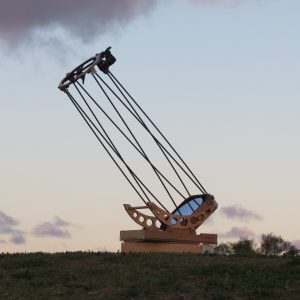
at least a good two-hour session of observing.
Now here’s the thing: I collimate my scopes at roughly a 45-degree angle, and not dead flat. I don’t know about you, but it’s a rare night when I have my scope remotely pointed at the horizon: there’s usually something in the way, and even if there isn’t, the seeing down low is like looking through the bottom of a schooner glass. You only do it for the novelty value – at my latitude, that includes picking off the Andromeda Galaxy or Whirlpool Galaxy as they pop up briefly over the horizon. If a scope can hold its own from about 25 degrees or so to 90 then I’m as happy as a pig in mud.
The Gondwana Telescopes version I had was not set up for Argo Navis, but this is readily available as an option (and Marana comes ready with encoder couplings) – of course, they’re both Aussie products after all. I don’t feel the absence of digital setting circles affected the review at all and think it in fact kept the attention squarely on the scope itself.
This version was equipped with Skywatcher optics, and while the test was not one of optics, they threw up a pretty sharp, scatter-free image. Part of that result comes down to the fact that the optics were allowed to perform; so it was a clear case of mission accomplished.
There are no fans on this scope. Alex likes to point out that you cannot force Pyrex to evenly cool faster than it wants to, and blowing a fan in the centre of a big mirror does nothing but create a cool constricted centre, a warmer expanded ring … and a bad image. As he points out, the massive professional observatory scopes are not built by astronomers, but by engineers, whose expertise does not lie in observing the stars but rather in the thermal properties of materials used in the construction of a scientific instrument.
The six-point flotation cell utilizes disc springs that are robust, strong and laterally stable, as opposed to compressional coil springs that tend to float about as they buckle with each twist of a collimation screw. The mirror stays exactly where you position it.
Eyepiece height at zenith is 170 cm (66.9 inches), and the Gondwana Telescopes scope unfurls itself from a box just 40 cm (15.75 inch) deep, 61.5 cm (24.2 inch) wide and 20 cm (7.9 inch) tall.
I’m out under the starry skies. What strikes me the most, straight up?
Given my penchant for heavy, robust scopes, I was really impressed that such a light scope could be so sure footed. It doesn’t feel flimsy. Its movements are smooth as silk but solid. Like a well-balanced Dob should, it moved obediently with the push of a single finger, and stopped exactly on queue.
Nudge tracking was as easy as it gets. Despite the Gondwana Telescopes light weight, a nudge moved the image, which then stayed put. No shimmying and shaking. It actually felt like my big rolled-steel Dob, only smoother and more precise. It really was quite unexpected.
The focuser board held the eyepieces in place, with no discernible flex evident for the one-side mount. The focuser is a 2-inch KineOptics HC-2 helical (Image 7) which also facilitates 2-inch filters with a specially designed threaded drawtube that means you can switch eyepieces without having to screw and unscrew filters all night. It also means you can use 2-inch filters with your 1.25-inch eyepieces.
And for its overall 21 kilograms (46.3 pounds) of weight, the way the Marana dealt with big eyepiece glass was amazing. A 13-mm Ethos? No counterweight required at all. Throw on a Paracorr 2 as well and this scope was sitting pretty with a tiny 1-kilogram (2.2-pound) counterweight that clipped on the back of the LTA.
The single counterweight dealt with a 21-mm Ethos with no problems. While I didn’t have a second counterweight handy, I am sure it would cope with the addition of the Paracorr just fine. The specially designed counter weight system was adopted by Alex on his observation that rip-cords, braking systems and clutches, only serve to change the action of a scope, and a lightweight instrument deals poorly with such hindrances.
So, were there any quibbles?
Only very minor ones, really. I’d like to see a bit of blackening on the primary mirror clips, as I’m a bit obsessive-compulsive about stray light, and at least in my suburban location, I would be keen to see a full top-to-bottom shroud. The metal clamps to attach the UTA are polished – these may show less wear and tear over time with a flat finish, as there is a bit of technique involved with loading the poles into position. But like I said, these are minor points indeed and simple to address.
But all in all …
Gondwana is offering a bigger version. Like 16 inches. Even if I’m only travelling out from under the stairs, it is well worth considering. I earned my stripes with the heavyweight DS-16 of yesteryear. I’ve seen the light, so to speak.
After all, fat lips sting like blazes in the cold night air!
By Sean Melehan:
Sean is an Associate Editor at Astronomy Technology Today and is an amateur astronomer who lives on LakeMacquarie, NSW, Australia, with his wife Sarah-Kate and daughter Savannah-Rose. Deep sky observing is Sean’s burning interest, and he loves nothing better than to sketch at the eyepiece. He is also a former journalist who learned his craft at the bush paper The Singleton Argus before working for the Newcastle Herald for 20 years. He left the ailing newspaper industry in 2012 to pursue a career in geology.
###
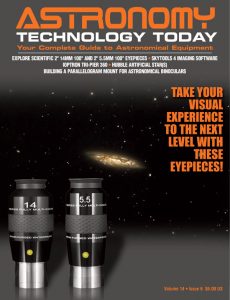 And to make it easier for you to get the most extensive telescope and amateur astronomy related news, articles and reviews that are only available in the magazine pages of Astronomy Technology Today, we are offering a 1 year subscription for only $6! Or, for an even better deal, we are offering 2 years for only $9. Click here to get these deals which only will be available for a very limited time. You can also check out a free sample issue here
And to make it easier for you to get the most extensive telescope and amateur astronomy related news, articles and reviews that are only available in the magazine pages of Astronomy Technology Today, we are offering a 1 year subscription for only $6! Or, for an even better deal, we are offering 2 years for only $9. Click here to get these deals which only will be available for a very limited time. You can also check out a free sample issue here



